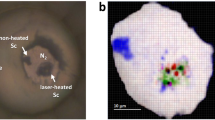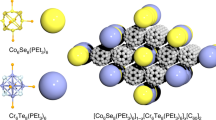Abstract
Silicon is ubiquitous in contemporary technology. The most stable form of silicon at ambient conditions takes on the structure of diamond (cF8, d-Si) and is an indirect bandgap semiconductor, which prevents it from being considered as a next-generation platform for semiconductor technologies1,2,3,4. Here, we report the formation of a new orthorhombic allotrope of silicon, Si24, using a novel two-step synthesis methodology. First, a Na4Si24 precursor was synthesized at high pressure5; second, sodium was removed from the precursor by a thermal ‘degassing’ process. The Cmcm structure of Si24, which has 24 Si atoms per unit cell (oC24), contains open channels along the crystallographic a-axis that are formed from six- and eight-membered sp3 silicon rings. This new allotrope possesses a quasidirect bandgap near 1.3 eV. Our combined experimental/theoretical study expands the known allotropy for element fourteen and the unique high-pressure precursor synthesis methodology demonstrates the potential for new materials with desirable properties.
This is a preview of subscription content, access via your institution
Access options
Subscribe to this journal
Receive 12 print issues and online access
$259.00 per year
only $21.58 per issue
Buy this article
- Purchase on Springer Link
- Instant access to full article PDF
Prices may be subject to local taxes which are calculated during checkout




Similar content being viewed by others
References
Ng, W. L. et al. An efficient room-temperature silicon-based light-emitting diode. Nature 410, 192–194 (2001).
Theis, T. N. & Solomon, P. M. It’s time to reinvent the transistor. Science 327, 1600–1601 (2010).
Fujita, M. Silicon photonics: Nanocavity brightens silicon. Nature Photon. 7, 264–265 (2013).
Botti, S., Flores-Livas, J. A., Amsler, M., Goedecker, S. & Marques, M. A. L. Low-energy silicon allotropes with strong absorption in the visible for photovoltaic applications. Phys. Rev. B 86, 121204(R) (2012).
Kurakevych, O. O., Strobel, T. A., Kim, D. Y., Muramatsu, T. & Struzhkin, V. V. Na–Si clathrates are high-pressure phases: A melt-based route to control stoichiometry and properties. Cryst. Growth Des. 13, 303–307 (2012).
Zwijnenburg, M. A., Jelfs, K. E. & Bromley, S. T. An extensive theoretical survey of low-density allotropy in silicon. Phys. Chem. Chem. Phys. 12, 8505–8512 (2010).
Xiang, H. J., Huang, B., Kan, E., Wei, S-H. & Gong, X. G. Towards direct-gap silicon phases by the inverse band structure approach. Phys. Rev. Lett. 110, 118702 (2013).
Malone, B. D. & Cohen, M. L. Prediction of a metastable phase of silicon in the Ibam structure. Phys. Rev. B 85, 024116 (2012).
Tonkov, E. Y. & Ponyatovsky, E. G. Phase Transformations of Elements Under High Pressure (CRC Press, 2005).
Wentorf, R. H. & Kasper, J. S. Two new forms of silicon. Science 139, 338–339 (1963).
Cros, C., Pouchard, M. & Hagenmuller, P. Sur deux nouvelles phases du système silicium-sodium. C. R. Acad. Sci. 260, 4764–4767 (1965).
Gryko, J. et al. Low-density framework form of crystalline silicon with a wide optical band gap. Phys. Rev. B 62, R7707–R7710 (2000).
Kasper, J. S., Hagenmuller, P., Pouchard, M. & Cros, C. Clathrate structure of silicon Na8Si46 and NaxSi136 (x < 11). Science 150, 1713–1714 (1965).
Schnering, H. V., Schwarz, M. & Nesper, R. The lithium sodium silicide Li3NaSi6 and the formation of allo-silicon. J. Less-Common Met. 137, 297–310 (1988).
Malone, B. D., Sau, J. D. & Cohen, M. L. Ab initio survey of the electronic structure of tetrahedrally bonded phases of silicon. Phys. Rev. B 78, 035210 (2008).
Besson, J. M., Mokhtari, E. H., Gonzalez, J. & Weill, G. Electrical properties semimetallic silicon III and semiconductive silicon IV at ambient pressure. Phys. Rev. Lett. 59, 473–476 (1987).
Dong, J., Sankey, O. F. & Kern, G. Theoretical study of the vibrational modes and their pressure dependence in the pure clathrate-II silicon framework. Phys. Rev. B 60, 950–958 (1999).
Shockley, W. & Queisser, H. J. Detailed balance limit of efficiency of pn junction solar cells. J. Appl. Phys. 32, 510–519 (1961).
Guloy, A. M. et al. A guest-free germanium clathrate. Nature 443, 320–323 (2006).
Connétable, D. Structural and electronic properties of p-doped silicon clathrates. Phy. Rev. B 75, 125202 (2007).
Bryan, J. D. & Stucky, G. D. Eu4Ga8Ge16: A new four-coordinate clathrate network. Chem. Mater. 13, 253–257 (2001).
Yamanaka, S. & Maekawa, S. Structural evolution of the binary system Ba–Si under high-pressure and high-temperature conditions. Z. Naturforsch. 61, 1493–1499 (2006).
Wosylus, A. et al. High-pressure synthesis of strontium hexasilicide. Z. Naturforsch. 61, 1485–1492 (2006).
Wosylus, A., Prots, Y., Burkhardt, U., Schnelle, W. & Schwarz, U. High-pressure synthesis of the electron-excess compound CaSi6 . Sci. Technol. Adv. Mater. 8, 383–388 (2007).
Wosylus, A. et al. Breaking the Zintl rule: High-pressure synthesis of binary EuSi6 and its ternary derivative EuSi6−xGax (0 ≤ x ≤ 0.6). Solid State Sci. 8, 773–781 (2006).
Stefanoski, S., Malliakas, C. D., Kanatzidis, M. G. & Nolas, G. S. Synthesis and structural characterization of NaxSi136 (0 < x ≤ 24) single crystal and low-temperature transport of polycrystalline specimens. Inorg. Chem. 51, 8686–8692 (2012).
Baerlocher, Ch., McCusker, L. B. & Olson, D. H. Atlas of Zeolite Framework Types Vol. 86, 6th revised edn (Elsevier, 2007).
Conesa, J. C. Computer modeling of allo-Si and allo-Ge polymorphs. J. Phys. Chem. B 106, 3402–3409 (2002).
Cundy, C. S. & Cox, P. A. The hydrothermal synthesis of zeolites: History and development from the earliest days to present time. Chem. Rev. 103, 663–701 (2003).
San-Miguel, A. et al. High pressure behavior of silicon clathrates: A new class of low compressibility materials. Phys. Rev. Lett. 83, 5290–5293 (1999).
Tritt, T. M. Semiconductors and Semimetals Vol. 69 (Academic, 2001).
Tauc, J., Grigorovici, R. & Vancu, A. Optical properties and electronic structure of amorphous germanium. Phys. Status Solidi 15, 627–637 (1966).
Salpeter, E. E. & Bethe, H. A. A relativistic equation for bound-state problems. Phys. Rev. 84, 1232–1242 (1951).
Albrecht, S., Reining, L., Sol, R. D. & Onida, G. Ab initio calculation of excitonic effects in the optical spectra of semiconductors. Phys. Rev. Lett. 80, 4510–4513 (1998).
Reference solar spectral irradiance: Air mass 1.5; http://rredc.nrel.gov/solar/spectra/am1.5
Alonso, M. I., Wakita, K., Pascual, J., Garriga, M. & Yamamoto, N. Optical functions and electronic structure of CuInSe2, CuGaSe2, CuInS2, and CuGaS2 . Phys. Rev. B 63, 075203 (2001).
Meng, Y. et al. High optical quality multicarat crystal diamond produced by chemical vapor deposition. Phys. Status Solidi A 209, 101–104 (2012).
Zwijnenburg, M. A., Illas, F. & Bromley, S. T. Apparent scarcity of low-density polymorphs of inorganic solids. Phys. Rev. Lett. 104, 175503 (2010).
Nguyen, M. C., Zhao, X., Wang, C-Z. & Ho, K-M. sp3-hybridized framework structure of group-14 elements discovered by genetic algorithm. Phys. Rev. B 89, 184112 (2014).
Acknowledgements
The experimental work was supported by DARPA under contract numbers W31P4Q-13-1-0005 and W911NF-11-1-0300. The theoretical work was supported by Energy Frontier Research in Extreme Environments (EFree) Center, an Energy Frontier Research Center funded by the US Department of Energy, Office of Science under award number DE-SC0001057. We thank T. Muramatsu and V. Struzhkin for assistance with electrical measurements, J. Holaday and Y. Kono for helping with experimental synthesis, J. Armstrong for support with SEM measurements, and J. Smith, B. Baptiste and H. Gou for help with XRD. Facilities and infrastructure support were provided by the following. Portions of this work were performed at HPCAT (Sector 16), Advanced Photon Source (APS), Argonne National Laboratory. HPCAT operations are supported by DOE-NNSA under Award No. DE-NA0001974 and DOE-BES under Award No. DE-FG02-99ER45775, with partial instrumentation funding by NSF. The Advanced Photon Source is a US Department of Energy (DOE) Office of Science User Facility operated for the DOE Office of Science by Argonne National Laboratory under Contract No. DE-AC02-06CH11357. X-ray diffraction facilities at the Geophysical Laboratory were supported, in part, by the WDC Research Fund. Na4Si24 precursor synthesis experiments with in situ XRD were performed at the ID06 beamline at the European Synchrotron Radiation Facility (ESRF), Grenoble, France. We are grateful to W. Crichton, J. Guignard and Y. Le Godec for providing assistance in using this beamline.
Author information
Authors and Affiliations
Contributions
D.Y.K. performed all theoretical calculations. S.S., O.O.K. and T.A.S. performed all experimental synthesis and characterization. All authors discussed the results and contributed to the manuscript.
Corresponding author
Ethics declarations
Competing interests
The authors declare that they have filed a provisional patent application.
Supplementary information
Supplementary Information
Supplementary Information (PDF 2430 kb)
Rights and permissions
About this article
Cite this article
Kim, D., Stefanoski, S., Kurakevych, O. et al. Synthesis of an open-framework allotrope of silicon. Nature Mater 14, 169–173 (2015). https://doi.org/10.1038/nmat4140
Received:
Accepted:
Published:
Issue Date:
DOI: https://doi.org/10.1038/nmat4140
This article is cited by
-
Direct bandgap emission from strain-doped germanium
Nature Communications (2024)
-
Edge Electronic States and Direct Bandgap in Si Nanostructures on Silicon Oxide
Transactions on Electrical and Electronic Materials (2024)
-
Atomistic deformation mechanism of silicon under laser-driven shock compression
Nature Communications (2022)
-
Stability of mixed carbon–silicon clathrates
Applied Physics A (2022)
-
Helium incorporation induced direct-gap silicides
npj Computational Materials (2021)



